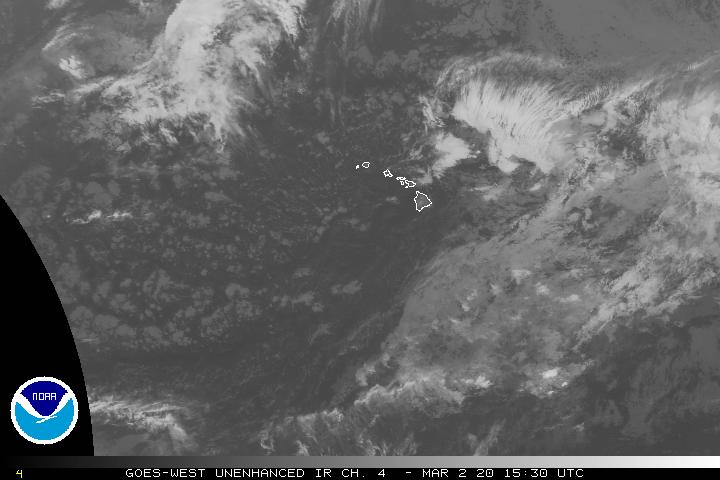Air Temperatures – The following high temperatures (F) were recorded across the state of Hawaii Saturday…along with the low temperatures Saturday:
79 – 62 Lihue, Kauai
83 – 67 Honolulu, Oahu
mm mm Molokai
81 – 59 Kahului AP, Maui
82 – 71 Kailua Kona
85 – 68 Hilo AP, Hawaii
Here are the latest 24-hour precipitation totals (inches) for each of the islands Saturday evening:
0.02 Kalaheo, Kauai
0.01 Poamoho RG 1, Oahu
0.00 Molokai
0.01 Lanai
0.03 Kahoolawe
0.05 West Wailuaiki, Maui
0.27 Saddle Quarry, Big Island
The following numbers represent the strongest wind gusts (mph) Saturday evening:
17 Waimea Heights, Kauai
16 Kuaokala, Oahu
07 Molokai
12 Lanai
13 Kahoolawe
08 Kula 1, Maui
18 Kaloko-Honokohau, Big Island
Hawaii’s Mountains – Here’s a link to the live webcam on the summit of our tallest mountain Mauna Kea (nearly 13,800 feet high) on the Big Island of Hawaii. Here’s the webcam for the Haleakala Crater on Maui. These webcams are available during the daylight hours here in the islands, and at night whenever there’s a big moon shining down. Also, at night you will be able to see the stars — and the sunrise and sunset too — depending upon weather conditions.
Aloha Paragraphs

High pressure west-northwest…storm and gale lows far north

High clouds north…and southeast of the Big Island

Mostly clear to partly cloudy…some cloudy areas

Just a few showers – Looping image
~~~ Hawaii Weather Narrative ~~~
Small Craft Advisory…all coasts and channels except Maalaea Bay
High Surf Warning…north and west shores of Niihau, Kauai, Oahu, Molokai, Big Island, and north shore of Maui
Broad Brush Overview: The generally light wind conditions will prompt daytime sea breezes and nighttime land breezes this weekend. Look for afternoon clouds, although with only a few showers, along with mostly clear and seasonably cool nights and mornings. The trades will return Monday, then strengthen and become strong and gusty by Wednesday. Windward and mountain showers may become more frequent Tuesday onward…as the trades increase.
Details: Dry weather prevail, which will remain in place through Monday. Weather maps show the islands in a very weak wind field, between high pressure ridges to the west and east, and a large area of low pressure well to the north. The resulting light wind flow is allowing a nighttime land breeze and daytime sea breeze regime to prevail over the islands. A surface ridge will remain over the state, then drift northward late Sunday through Monday. Trade winds will become more defined Sunday night and Monday into Tuesday onward.
Looking Further Ahead: A robust high will park itself to our north by Wednesday, in the wake of a weak cold front. The front won’t have any influence on our weather, although the building high will cause trade winds to increase significantly, with 25-35 mph winds over the open ocean. Winds this strong interacting with island terrain in a stable environment may require a Wind Advisory. The models then show the trades decreasing somewhat Friday into next weekend…as a weak surface trough develops to the west of the state.
Here’s a wind profile of the Pacific Ocean – Closer view of the islands / Here’s the vog forecast animation / Here’s the latest weather map
Marine environment details: The extra large northwest swell will build rapidly, bringing surf heights well above warning levels to exposed shores on the smaller islands, and to the Big Island a bit later. Warning level surf will continue through this weekend and possibly into Monday. As the swell subsides, surf should remain at advisory levels into mid-week before…another northwest swell arrives Wednesday night.
A Small Craft Advisory (SCA) is in effect for all Hawaiian coastal waters, except Maalaea Bay, due to seas. A ridge over the state will keep winds light through the weekend. The ridge will move north late Sunday, with moderate to locally stronger trade winds returning at the beginning of the work week. Winds will then increase through the new week.
Extra large swells have the potential to cause significant impacts to shorelines, especially ones already prone to erosion. This type of event usually generates well above coastal overwash, especially when coinciding with high tides. The highest tide throughout the state will occur again between 130 and 300am Sunday morning, with values between 1.6 and 2.6 ft. Additionally, harbors with northern and northwestern exposures could see impacts from potential surging.

Very large surf on the north and west shores
World-wide Tropical Cyclone activity
>>> Here’s the latest PDC Weather Wall Presentation, covering Tropical Cyclone 06S (Berguitta) in the South Indian Ocean, along with a tropical disturbance being referred to as Invest 90W east of Singapore, Malaysia
![]()
>>> Atlantic Ocean:
>>> Caribbean Sea:
>>> Gulf of Mexico:
Here’s a satellite image of the Caribbean Sea…and the Gulf of Mexico
Here’s the link to the National Hurricane Center (NHC)
>>> Eastern Pacific:
Here’s a wide satellite image that covers the entire area between Mexico, out through the central Pacific…to the International Dateline.
Here’s the link to the National Hurricane Center (NHC)
>>> Central Pacific:
Here’s a link to the Central Pacific Hurricane Center (CPHC)
>>> Northwest Pacific Ocean: No active tropical cyclones
>>> North and South Indian Oceans / Arabian Sea:
Tropical Cyclone 06S (Breguitta)
JTWC textual forecast warning
JTWC graphical track map
NOAA satellite image
Here’s a link to the Joint Typhoon Warning Center (JTWC)
Interesting: Huge Glaciers Found Hiding Beneath Mars Surface – Sizable deposits of water ice lurk just beneath the surface in some regions of Mars, a new study reports.
The newfound sheets appear to contain distinct layers, suggesting that studying them could shed considerable light on the Red Planet’s climate history, researchers said. And the ice is buried by just a few feet of Martian dirt in places, meaning it might be accessible to future crewed missions.
“I’m not familiar with resource-extraction technology, but this may be information that’s useful to people who are,” study lead author Colin Dundas, of the U.S. Geological Survey’s Astrogeology Science Center in Flagstaff, Arizona.
Dundas and his colleagues analyzed photos captured over the years by the High Resolution Imaging Science Experiment (HiRISE) camera aboard NASA’s Mars Reconnaissance Orbiter (MRO). They identified eight locations where erosion had exposed apparent glaciers, some of which extend 330 feet or more into the Red Planet’s subsurface.
These sites are steep, pole-facing slopes in Mars’ midlatitudes, between about 55 and 60 degrees both north and south of the equator. The ice-harboring areas sport few craters, suggesting they’re quite young, geologically speaking, the researchers said.
Interestingly, scientists think that Mars’ obliquity — the tilt of the planet’s axis relative to the plane of its orbit — has shifted a fair bit over the past few million years, varying between about 15 and 35 degrees, Dundas said. (The Red Planet’s obliquity is currently about 25 degrees; Earth’s is 23.5 degrees.)
“There’ve been suggestions that, when there’s high obliquity, the poles get heated a lot — they’re tilted over and pointed more at the sun, and so that redistributes ice toward the midlatitudes,” Dundas said. “So, what we may be seeing is evidence of that having happened in the past.”
Researchers already knew that Mars harbors subsurface water ice, and lots of it. For example, MRO’s ground-penetrating Shallow Radar instrument recently found a buried ice layer that covers more ground than the state of New Mexico. (NASA’s Phoenix lander also dug up some ice near the Martian north pole in 2008, but it’s unclear if that stuff is part of a big sheet.)
But the newly analyzed HiRISE data give researchers more detailed looks at such deposits, Dundas said.
“The take-home message is, these are nice exposures that teach us about the 3D structure of the ice, including that the ice sheets begin shallowly, and also that there are fine layers,” he said.
The new study was published online in the journal Science.












 Email Glenn James:
Email Glenn James:
Jacob Says:
Hi Glenn, thanks for these updates. We are coming to the Lahaina/Maui area January 22-27. Getting nervous about the forecasts showing all the wind and cloudiness. Is it still too far out to know too accurately the cloud cover, temps, and wind there for that week? Our first time to go to Maui and now I’m getting discouraged about all the early extended weather forecast of clouds and rain….
~~~ Hi Jacob, good to hear that you’ll be coming to the Lahaina area later this month…lucky you!
As for the expected weather conditions then, I don’t have a clue…literally. It wouldn’t worry if I was you, as no one really knows what will be happening then. However, often Lahaina is one of the driest and warmest places on the island…good luck!
Aloha, Glenn
Theodore Bennett Says:
Aloha Glenn!
I, too, regularly check your weather site. Thank you for continuing to keep this active, even as you care for your Mom in Long Beach. I went to grammar school in Long Beach, but now I live near South Point and am a small natural farmer.
You had several readings of highest precipitation totals in the last week that included Big Island Highs from South Point. I can assure you we had 0.00 here at 1,200 ft, so I am curious where the South Point data is collected? Perhaps you could email me?? Also, should it say Email where you have Mail to leave a comment?
My best,
Mahalo!
Aloha!
Ted
~~~ Hi Ted, when it rains it pours…three great positive affirmations of my website today!
Yeah, I went to Carver Elementary, Marshall Jr. High…and Milliken HS. I also graduated from Long Beach City College, before heading north to do my University work in Sonoma County.
We both then moved to Hawaii, you to the Big Island, and Maui for me. I think small natural farming is great, I just returned from a small farm I go to here in Kula, where I hand picked carrots, beets, kale, and got a dozen eggs…all organic.
The South Point rain gauge doesn’t show up on the NWS map:
http://www.prh.noaa.gov/hnl/graphics/hydro/coop_bigis.jpg
not sure where it is?
Thanks for writing, and I’m so pleased that you find value in clicking on my online website!
Aloha, Glenn
Diane Says:
Dear Glenn,
Happy New Year to You and Mom!!!!
I HAD to comment, yet again, on your “interesting”. I’m shaking my head with a big smile on my face. The Siberia information was outstanding, I especially appreciated the summary paragraph.
Today, for the first time, I ventured to the “closer view” under “Hawaii Weather Narrative”…the capabilities of customizing what you want to know, blows me away, no pun intended!
As always, the photographs are sent to my friends, especially those who are feeling anxious.
I have said this numerous times, I love your website.
Aloha🌴
Diane
Nor CA
~~~ Hi Diane, thanks for your well wishes to my Mom and I. I just flew back to Maui last evening, and will be here for a couple of weeks.
Glad you are still enjoying the Interesting paragraphs, I try and keep the information mixed up, covering the four corners of the earth…past, present and future too.
I love that you love my website!
All the best…
Aloha, Glenn
Tom Says:
Aloha Glenn:
Big mahalo for your continuing to raise the bar in weather education for our Hawaiian islands. I moved a year ago from Honolulu to Kapa’a and the weather is a whole different experience. I love it here and am so glad I could refer to your site to keep my awareness transitioning to Kauai style.
The Windy.com addition is so comprehensive. Is there a tutorial somewhere so I can learn how to understand more of the content?
So appreciate your work and a great fan.
Mahalo,
Tom
~~~ Hi Tom, I welcome your positive feedback…thank you very much!
Glad you’re enjoying your move to Kauai, and are learning new things about the weather on that great island.
Glad too that you’re finding value using the Windy.com tool, it’s a good one for sure! As for a tutorial, I don’t know of one, although I’ll keep my eye out.
All the best…
Aloha, Glenn